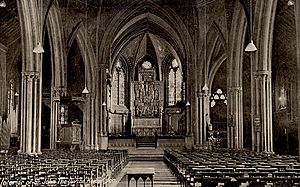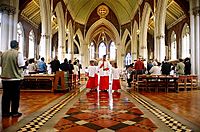St John the Divine, Kennington facts for kids
Quick facts for kids St John the Divine, Kennington |
|
|---|---|

Photo of the church
|
|
| Location | Vassall Road, Kennington, London |
| Country | United Kingdom |
| Denomination | Church of England |
| Churchmanship | Anglo-Catholic |
| History | |
| Founded | 14 November 1874 |
| Founder(s) | The Reverend Daniel Elsdale |
| Architecture | |
| Architect(s) | George Edmund Street |
| Style | Gothic Revival architecture |
| Years built | 1871 through 1874 |
| Administration | |
| Parish | Kennington |
| Diocese | Anglican Diocese of Southwark |
St John the Divine, Kennington is a beautiful Anglican church located in London. It's part of the Anglican Diocese of Southwark, which covers the Kennington area. A famous architect named George Edmund Street designed the church. He also designed the Royal Courts of Justice in London! The church was built between 1871 and 1874 in a style called 'Decorated Gothic'. Today, it's a very important building, known as a Grade I listed building. This means it's protected because of its special history and architecture.
You can find the church on Vassall Road in Kennington, London. It's in the Lambeth area. It's close to Oval tube station and the Oval Cricket Ground, a famous sports stadium. Its tall spire can be seen from far away!
Contents
Discovering the Church's Design
This church is a great example of Victorian Gothic style. It is a Grade I listed building, meaning it's very important. The church is mostly built from red brick. However, all the fancy parts like the tops of walls (parapets), window frames, and doorways are made of stone. The very top of the spire is also completely made of stone.
At 61 meters (200 feet) tall, it has the tallest spire in South London. You can see it from miles around! The famous poet John Betjeman once said that St John the Divine was "the most magnificent church in South London."
The inside of the church was first designed by George Frederick Bodley. He was also the founder of a company called Watts & Co. The interior was very detailed and fancy, which was common for churches built in the Victorian era and for Anglo-Catholic churches. It had stone carvings by Thomas Earp, beautiful metal altar rails, stained glass windows, and a carved screen behind the altar. This screen was painted by Clayton and Bell. A new organ was added in 1875 by J. W. Walker & Sons Ltd.
Sadly, the church was badly damaged by bombs in 1941 during the Blitz (a time of heavy bombing in London). Most of the original inside decorations were lost. After many years of repair work, led by H. S. Goodhart-Rendel, St John the Divine reopened in September 1958.
The Tower and Its Carvings
The church's tall spire and tower were repaired in 1994. During this work, new carved figures called grotesques and gargoyles were added. Many of these carvings look like real people! They show members of the church, people from the British Royal Family, or church leaders.
You can spot carvings of famous figures like the Queen, King Charles, Prince William, and Archbishop Michael Ramsey.
Beautiful Stained Glass Windows
Much of the original stained glass was destroyed in the 1941 bombing. It has been replaced with clear glass windows in the north and south aisles. However, some original stained glass designed by Charles Eamer Kempe still remains. This includes the large window at the west end and two windows in the south aisle. The windows at the east end of the church are also original.
During the restoration, new windows were designed and made by W. T. Carter Shapland. These beautiful new windows were placed in the All Souls Chapel.
Amazing Murals Behind the Altar
Behind the main altar, there are large paintings called murals. These were painted by Brian Thomas in 1966. The painting on the left shows the Virgin Mary and Jesus in a garden filled with flowers. The middle painting has lilies and roses, which are symbols often linked to Mary. The painting on the right shows a pietà, which is Mary holding the body of Jesus after he was crucified. Instead of flowers, this panel is framed with thorns, representing the crown of thorns.
The Korean Icon
Above the North door, you'll see something special called the 'Korean Icon'. It looks like a screen you might find in a Greek Orthodox church. It shows different people from the Christian Gospels (stories about Jesus). This icon was put there to remember Bishop Charles John Corfe. He started the Anglican Church of Korea way back in 1890.
The Kelham Rood Sculpture
On the south side of the main part of the church (the nave), stands the Kelham Rood. This is a life-size bronze sculpture of Christ on the Cross. It also includes separate figures of St John and the Virgin Mary. The famous sculptor Charles Sargeant Jagger created this work. He also designed the Royal Artillery Memorial in London's Hyde Park Corner. The sculpture was finished in 1929.
This sculpture was first made for a chapel at Kelham Hall in Nottinghamshire. Later, it was moved to a priory (a type of monastery) in Willen (Milton Keynes). Finally, it found its home at St John the Divine. It was originally planned to hang above the main altar. However, it was placed at floor level instead. This allows people in the church to see it up close.
Worship and Traditions
Since it was founded in 1871, St John the Divine has been known for its high church style of worship. This means it has more traditional and ceremonial services. The second vicar (church leader), Rev. Charles Edward Brooke, was part of the Oxford Movement. This movement focused on traditional practices and helping poor city areas. At that time, some church practices were limited by a law called the Public Worship Regulation Act of 1874.
The 'High Anglican' style of worship is clear in how the church is designed and decorated. You can see statues, icons (religious images), sanctuary lamps (lamps that stay lit), and the Reserved sacrament (blessed bread and wine kept in the church). These traditions continue today. Services are usually in the Anglo-Catholic style, which means they focus on sacraments, liturgy (the order of service), and ceremony.
On Sundays and special holy days, the clergy wear decorated robes. A choir sings the Mass, and incense is used. During the week, Mass is held daily. The services usually follow the Common Worship prayer book, which was created in 2000.
The Sisterhood of St. John the Divine, a group of Anglican nuns, is indirectly named after this church. Their founder, Hannah Grier Coome, found spiritual comfort here when she lived in Britain.
Notable Clergy Members
- Cyril Easthaugh: He served as a curate and vicar here. Later, he became a Bishop.
- Cathrew Fisher: He was an assistant curate. He later became the Bishop of Nyasaland.
- John Hall: He was a curate here. He later became the Dean of Westminster.
See Also
- List of churches and cathedrals of London
- List of Anglo-Catholic Churches
- British and Irish stained glass (1811–1918)



